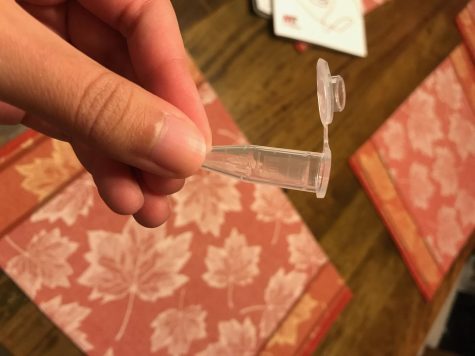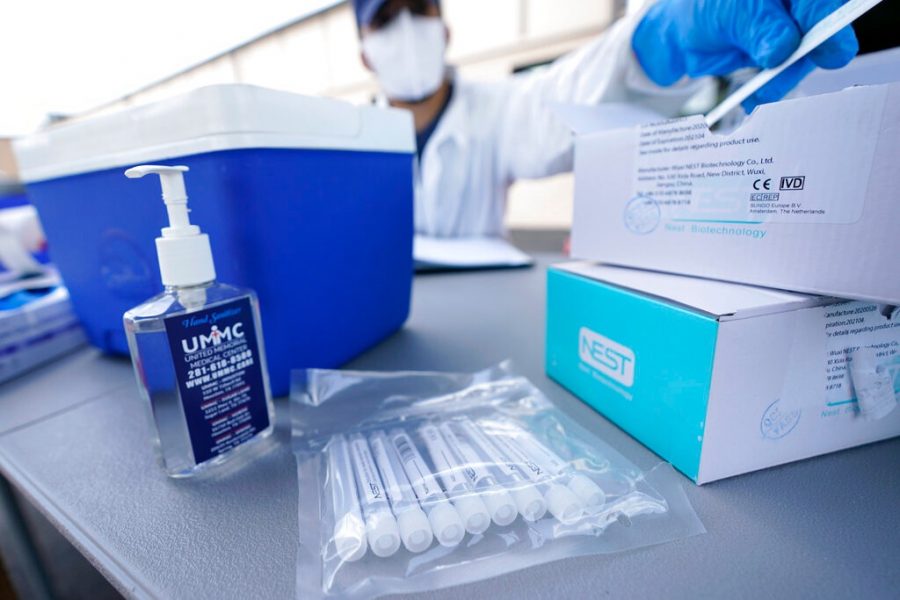Students and staff partake in COVID-19 screening as school transitions to hybrid
Administration hopes that “significant mitigation effort” will forestall coronavirus cases
AP News
Students and staff utilize a non-diagnostic screening test, similar to this one used at the United Memorial Medical Center in Texas
On Nov. 10, New Trier kicked off its COVID-19 screening program for students and staff returning to the building for hybrid learning.
The test identified 15 presumptive positive cases among the 1,920 students and staff that opted into the program—a 0.78% positivity rate—according to an email sent from New Trier’s Reopening Advisory Board on Nov. 14.
Before beginning in-person instruction, Trevians received sample tubes and instructions for collecting saliva samples. The screening process involves spitting into a tube, placing the tube in the provided bag, and sanitizing the bag.
According to senior Hailey Fitzsimmons, the test was simple to complete and safe to drop off.
“I appreciated the school giving us the opportunity to [get screened],” said Fitzsimmons.
Per a briefing issued by the Board of Education on Oct. 13, the tool, called RT-LAMP, is non-diagnostic. Students and staff who screen positive will be required to quarantine and contact their doctor or a state testing center to schedule a polymerase chain reaction (PCR) test to confirm the results.
Board member Greg Robitaille emphasized this distinction at the Nov. 4 board meeting. “The screening system is simply an indicator to prompt a student or staff member to go get a test,” he explained. “It will presumptively come back positive.”
New Trier conducted a pilot using samples from selected students and staff during the week of Oct. 5. According to the Reopening Advisory Board, the pilot went smoothly with same-day results and no presumptive positive tests.

However, the school’s website reminds students and staff that the screening program does come with a risk of false negatives. While effective at identifying individuals with high COVID-19 viral loads, the sensitivity limit of RT-LAMP does not pick up all cases from those with very low viral loads.
Carol Duccomon, a member of the Board of Education, explained that the RT-LAMP test identifies 85-90% of cases that the PCR test does—a relatively low accuracy rate. The administration reiterated that, after being flagged by the RT-LAMP test, students and staff are expected to get a PCR test to confirm the results.
Assistant Superintendent Chris Johnson acknowledged this potential risk at the Nov 4. board meeting.
“We know that there will be asymptomatic or pre-symptomatic students and staff that aren’t identified by the screening test—that’s just a part of being in this pandemic,” said Johnson.
New Trier’s Reopening Advisory Board members hope that the screening program will identify potential cases in the school population early, reducing transmission.
Notably, moving to 25% in-person instruction, the fourth out of six steps in the Board’s “reopening ladder,” violated the Board’s previously-defined metrics that dictated when returning to campus was appropriate. As of Nov. 15, Cook County saw 465 new COVID cases per 100,000 people per day, putting the county squarely in the highest-risk category (Illinois Department of Public Health). For reference, the county would need to see fewer than 25 cases per 100,000 people per day to be in the second highest-risk category.
Nevertheless, the Board has faith in the efficacy of the screening program.
“It’s a significant mitigation effort to reduce the risk of COVID-19 exposure in the building,” explained Superintendent Paul Sally in an interview with news editor Leah Schmidt. “If we’re able to screen asymptomatic positive students or staff out before they come on campus, everyone in the building is safer.”
According to the email sent by the Reopening Advisory Board, beginning the week of Nov. 16, all students scheduled to enter the building for athletic or extracurricular activities must submit a saliva sample the Sunday or Monday before doing so. This marks a departure from prior guidelines, where testing in advance of extracurricular activities was optional.
Members of the Reopening Advisory Board emphasize that the RT-LAMP screening program can only be one part of the school’s attempt to reduce transmission of the coronavirus. According to Johnson, the screening does not take the place of safety measures like mask-wearing, PPE, social distancing, and enhanced cleaning.
One week into hybrid learning, however, students and staff are split on whether or not the decision to reopen New Trier was a rational one.
Some students, like senior Rory McKeough, were pleasantly surprised by the safety measures put in place by the school.
“It wasn’t as bad as I was expecting,” said McKeough. “I didn’t realize just how beneficial the presence of classmates was. I could ask them questions if I didn’t understand something, and being able to talk on breaks was nice.”
Other students, like Fitzsimmons, are less optimistic about New Trier’s decision to reopen.
“As a member of the community, New Trier’s decision was disappointing. Not only did the school completely disregard the current metrics of spiking cases, but they also threw aside the system of stages that they had created earlier this year,” said Fitzsimmons.
When attending in-person instruction on Monday, Fitzsimmons noted a lack of social distancing during passing periods and certain class situations.
“When maneuvering around classrooms, it was common to be standing within 6 feet of either peers or teachers for a minute or two,” said Ftizsimmons.
“I felt particularly bad for teachers as they had less of a choice on whether or not they could stay away from school, and were therefore put in a more dangerous situation than the students.”
At the Nov. 4 board meeting, New Trier staff voiced similar concerns, given that the decision to move forward to the fourth step of the “reopening ladder” was in violation of previously-defined metrics regarding COVID cases.
“In this very uncertain world, the New Trier COVID dashboard has provided faculty with a measure of certainty. [The metrics] represent a promise to keep us and our students safe,” said French teacher Judy Weiss, addressing the Reopening Advisory Board. “To abandon them when we need them most, when they are fire-engine red with warning, is to break your promise to us.”








































